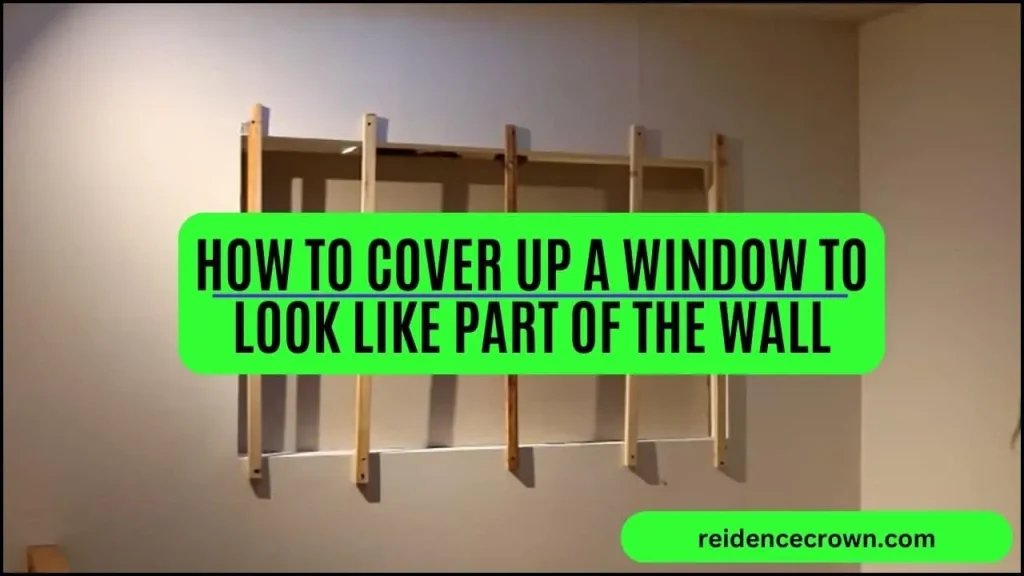Are you worried about covering up a window to look like a part of your house wall? Then this article is going to provide you a comprehensive response to this question.
People tend to cover up any window for adding wall space. Sometimes they need to cover some damages or block light/ outside noise.
As a result, they frequently seek ways to conceal the window so that it appears to be a part of the wall.
Let’s get right to the point of how to cover up a window to look like part of the wall.
Methods like drywall insulation can be a good solution. Continue reading to learn some tips to cover up a window to look like part of the wall.

Cover Up a Window to Look Like Part of the Wall?
It is achievable to hide a window permanently in such a way that no one will notice. It will seem that it was not ever there. Let us go through the steps in more detail.
Removing the window trim:
The Moldings that cover a window’s jambs, head and apron are called window trim. Window sills are also a component of trim. Firstly you need to remove the trim by using a pry bar. The sill can be hit with any instrument, such as a hammer.
Calculating the dimensions:
Remove any blemishes left on the wall while removing the trim and sill. It makes the windows cavity clear and smooth to measure the dimensions.
Cutting and attaching the wood:
Next you need to do some cutting tasks. To fit the interior of the window cavity, you will need to build a structure of 1×1 square inch planks.
Chop saw or hand saw can be useful tools for cutting. You should cut a piece of plywood to fit the window cavity’s measurements. Any kind of saw such as a jigsaw or circular saw can be used to perform this task.
Using a utility knife, cut a chunk of drywall to conform to the shape of the window cavity.
After this, you need to add the plywood and drywall widths together for the depth calculation. With this measurement, you should fasten the structure of 1×1 square inch to the windows interior. Wooden pins are often used to secure the structure.
Filling the cavity with insulation:
To cover the cavity, grab a piece of fiberglass insulation. Fiberglass insulation is a naturally sound-absorbing substance that decreases sound transmission considerably in walls and floors.
It is easy to cut with scissors since it is very flexible. Now, place the insulation beneath the 1×1 square inch structure in the cavity.
Placing the plywood and drywall:
At first, you have tol place the plywood against the structure in the hollow. You can attach the plywood to the framework planks by using screws.
After this, you will have to place the drywall in the cavity against the plywood so that it is leveled with the adjoining wall’s surface. Using drywall fasteners, fasten the drywall to the plywood.
Applying a joint compound and perfecting it:
Using a razor knife, you can apply a layer of joint compound to the crack between the new drywall and the older wall. For this, you can use the knife’s end to grab a part of the joint compound and drag it down the stitching.
You need to do something to make it look perfect. Over the damp compound, you can apply drywall tape to the crack.
By running over the tape with the knife, you may smooth it out. You should allow the joint compound to cure completely before removing any other flaws.
Necessary tips to mention before painting:
To replicate the texture of the existing wall, you have to use appropriate joint compound. You must let the texture dry completely.
Before you begin painting, you must first apply the primer. You must also ensure that the color you choose is the same as your house wall.
Painting the wall:
After you’ve completed all of the steps, you’ll need to paint the wall to make it seem completely integrated with the rest of the wall.
Verdict:
I hope you’ve found this information to be helpful. And you know how to cover up a window to look like part of the wall, right?
Now it’s your turn to try these steps. Best of luck.
